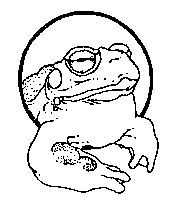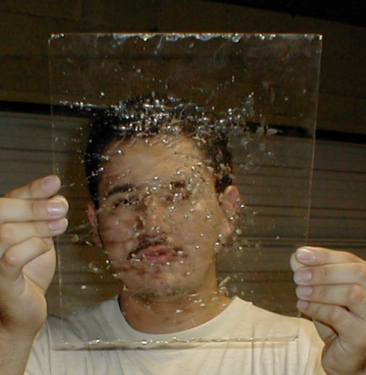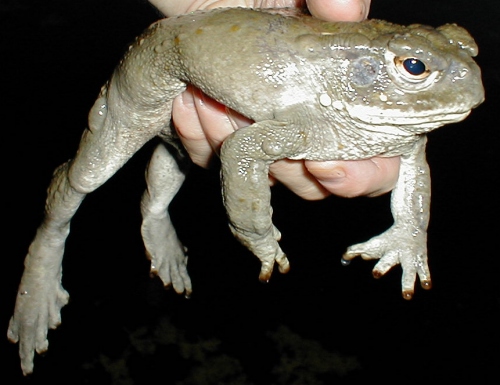 The Sonoran Desert Toad
The Sonoran Desert Toad
 The Sonoran Desert Toad
The Sonoran Desert Toad

Note: O-methylbufotenine is 5-MeO-DMT. (See the information below regarding chemical nomenclature.)
5-Methoxy- and 5-Hydroxy-Indolealkylamines in the Skin of Bufo alvarius
By Erspamer, Vittorio, T. Vitali, M. Roseghini, and Jose M. Cei
Experientia 1965 21:504.
And
5-Methoxy- and 5-Hydroxyindoles in the Skin of Bufo alvarius
By Erspamer, Vittorio, T. Vitali, M. Roseghini, and Jose M. Cei
Biochemical Pharmacology 1967 16:1149-1164.
Abstract:
The skin of Bufo alvarius, a desert toad of Arizona, contains a number of
indolealkylamines and their metabolites belonging to the common series of 5-hydroxy-indolealkylamines and to the unusual series of
5-methoxyindolealkylamines.
The most abundant representative of 5-hydroxyindolealkylamines is, as in
numerous other toads, bufotenine (up to 3 mg per g dry skin), the most abundant
representative of 5-methoxyindolealkylamines, O-methylbufotenine. In
parotoid and coxal glands as much as 5-15 per cent of the dry weight is made up
of this compound. Natural O-methyl-bufotenine has been isolated in a pure form
and itís identity with synthetic O-methyl-bufotenine definitely established.
The B. alvarius skin presents three sulphur-containing indolealkylamines: one
is bufoviridine, the well known O-sulphate of bufotenine, the other two are
completely new compounds with sulphuric acid probably attached to the > NH
group of the indole nucleus.
All hitherto described metabolites arising from the oxidative deamination of
5-hydroxy- and 5-methoxy-indolealkylamines may be found in the B. alvarius skin:
5-hydroxytryptophol, 5-hydroxyindoleacetic acid, 5-methoxytryptophol and 5-methoxy-indoleacetic acid.
The occurrence of the above compounds points to the necessary presence in B.
alvarius skin of a number of enzymes: tryptophan 5-hydroxylase, catalysing the
formation of 5-hydroxytryptophan, aromatic L-aminoacid decarboxylase producing
the decarboxylation of 5-hydroxytryptophan to 5-hydroxytryptamine, N-methyl and
O-methyl-indolealkylamines, and finally sulphoconjugases catalysing the linkage
of sulphuric acid to the 5-hydroxy group and the > NH group of the indole
nucleus.
The exceptionally rich sample card of indolealkylamines in the skin of B.
alvarius seems of interest not only from the point of view of comparative
biochemistry, but also from that of comparative enzymology and biochemical
taxonomy.
From page 1157: Table 5. The Content of Bufotenine and O-Methylbufotenine in the Skin of the Individual Examined specimens of Bufo alvarius
(G = large cutaneous glands; RS = remaining skin)
|
Toad |
Bufotenine (mg base/g dry tissue) |
O-Methylbufotenine (mg base/g dry tissue) |
|
|
G |
RS |
G |
RS |
|
I |
2.2 |
1.5 |
70 |
2.7 |
|
II |
1.1 |
2.1 |
140 |
2.6 |
|
III |
0.9 |
0.3 |
85 |
1.0 |
|
IV |
2.5 |
1.0 |
65 |
2.3 |
|
V |
5.0 |
1.3 |
90 |
1.7 |
|
VI |
3.5 |
1.4 |
105 |
2.0 |
|
VII |
0.8 |
1.1 |
50 |
2.3 |
|
VIII |
3.2 |
0.8 |
85 |
1.7 |
|
IX |
1.4 |
1.0 |
105 |
3.0 |
|
X |
0.9 |
0.6 |
140 |
1.5 |
|
[XI - missing] |
|
|
|
|
|
XII |
1.4 |
0.2 |
50 |
1.0 |
|
XIII |
2.0 |
2.2 |
70 |
0.9 |
|
XIV |
0.4 |
0.5 |
130 |
4.0 |
|
XV |
0.35 |
0.75 |
105 |
2.0 |
|
XVI |
0.3 |
0.55 |
150 |
2.2 |
|
XVII |
0.5 |
1.2 |
130 |
3.5 |
|
XVIII |
<0.1 |
0.17 |
50 |
0.6 |
|
XIX |
<0.2 |
0.62 |
125 |
0.42 |
|
XX |
<0.2 |
0.50 |
120 |
0.75 |
|
XXI |
<.0.2 |
0.87 |
90 |
0.5 |
Commentary: This the Grandfather of all Bufo alvarius psychoactivity research which established the level of bufotenine contained in this toadís venom to be up to 3 mg/ g dry skin, and the level of 5-MeO-DMT (O-methylbufotenine) contained in the venom to be as much as 5-15mg/g dry skin. It is important to note that in this study, the material examined was the ENTIRE parotoid gland and the venom contained within it. Had they simply extracted the venom and tested it alone, I believe they would have found the presence of 5-MeO-DMT to be greater than 5-15% and the presence of bufotenine to be greater than 3%, even though they did find that these substances also exist in the skin itself.
Additionally, the researchers only used twenty-one toads in their study and the level of compounds varied dramatically from one toad to the next. Their results from the twenty values give an average of 9.8% of 5-MeO-DMT per gram of dried skin.
While the actual level of 5-MeO-DMT contained in the venom may be somewhat higher than this study concluded, the variability in the amount of this compound present in any toad's
venom may render this conclusion irrelevant in practicality. One may never be completely sure how much of the
active compounds are actually present in any given dose. (See Table
5)
That's one basic problem with all natural sources of drugs, the potency varies greatly. This is even more of an issue for 5-MeO-DMT, since the dose is an important variable.
Therefore, it is important to milk as many toads as possible and to combine and mix the venom as thoroughly as possible in order to standardize the dose. This is most easily done by collecting all the venom in the same spot on a glass plate, and then chopping it all up together with a razor blade at the end of the night before the venom is almost completely dry. Once the venom has
thoroughly dried, you should blend it further into a uniform consistency by crushing the venom into a fine powder using a mortar and
pestle, or some similar device.
Store the venom frozen in a container that blocks out light, such as a film canister for long-term storage. Condensation usually occurs when you take the container out of the freezer, so leave it sealed until it warms up.

N,N-dimethyl-5-hydroxytrytamine; bufotenine
N,N-dimethyl-5-methoxytrytamine; O-methylbufotenine; (5-methoxy-N,N-dimethyltrypamine;
5-MeO-DMT)
5-methoxytryptophol
5-methoxyindoleacetic acid
5-hydroxytryptophol
5-hydroxyindoleacetic acid
N-methyl-5-methoxytryptamine
N-methyl-5-hydroxytryptamine
bufoviridine; N,N-dimethyl-5-hydroxytrytamine-O-sulfate
5-hydroxytryptamine; 5-HT; serotonin; enteramine; thrombocytin; thrombotonin
N-methyl-serotonin
tryptophan
bufotalindin; hellebrigenin; (a bufogenin - cardioactive sterol)
Also of note: "So far, 5-methoxyindoles have been described only in some South American vegetables and, in animals, only in the pineal gland of mammals and birds." p.1161
Also see the "textfiles" on Toad Toxins by David G. Spoerke, M.S., RPh., 1986
And also see Shulgin's TiHKAL, #19. 5-HO-DMT - bufotenine - as hosted on Erowid.
#####
From Bob Wallace:
The following expressions all describe the same substance:
3-{2-Dimethylaminoethyl}-5-methoxondole;
N,N-Dimethyl-5-methoxytryptamine;
5-Methoxy-N,N-dimethyltryptamine;
5-MeO-DMT;
O-methylbufotenine
Different nomenclature exists because Chemists are also humans, and so chemical names evolve over time
the same as for other names. Think of all the different names for dried cannabis (marijuana, pot, kind bud, etc.), or many other common
things (car=auto=automobile). Often shorter words replace longer words or phrases, kind of "linguistic
laziness".
Of the names above, I think the first is based on a standard way of naming chemicals, kind of the formal name. The second
and third is the full, everyday name. The forth is an abbreviated form of the
second and third. The fifth is an alternate name.
All these names are descriptive, and generally there are many ways to describe things.
For example, the second and third names are like "the red, metal ball" or "the metal, red ball".
In the context of a discussion, one might be more clear by emphasizing one aspect of the molecule, such as
"The N,N-dimethyltryptamine family includes the variations
5-methoxy-N,N-dimethyltryptamine as well as
5-hydroxy-N,N-dimethyltryptamine (bufotenine), and
4-hydroxy-N,N-dimethyltryptamine (psilocin)."
- Bob Wallace (just my opinion)
And from Roswell:
Chemical nomenclature is often quite complicated. It is always much simpler to draw out the substances. I believe tryptamine is an indole ring with
(-CH2CH2NH2) at the 3 position and (-OMe) at the 5 position. The dimethyl analog has two methyl groups attached to the same nitrogen (hence N,N). But,
if you're not an organic chemist, that won't make much sense to you.
See Bufo alvarius venom Bibliography